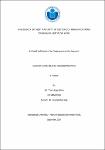| dc.contributor.author | Nhan, Tran Hoang | |
| dc.date.accessioned | 2015-05-25T08:30:29Z | |
| dc.date.accessioned | 2018-05-28T09:08:37Z | |
| dc.date.available | 2015-05-25T08:30:29Z | |
| dc.date.available | 2018-05-28T09:08:37Z | |
| dc.date.issued | 2014 | |
| dc.identifier.uri | http://10.8.20.7:8080/xmlui/handle/123456789/1297 | |
| dc.description.abstract | This study investigates the relationship between several macro economic as well as firm
specific factors that affect the debt maturity structure of a company by applying Least
Square Dummy Variable regression model . The study sample consists of 98
manufacturing companies listed on HOSE and the examined period is from the first
quarter of 2008 to the fourth quarter of 2012. Liquidity risk and signaling, agency
costs, equity market conditions, tax minimization and gap filling are adapted in our
model in order to make hypotheses . Several examinations are made to see whether time
or industries have any influence on company choice of debt maturity structure or if the
decision is made independently. As for the liquidity risk theory, the main concern lies in
postponing the refinancing risk, which is controlled by taking on debt of longer
maturities. The gap filling hypothesis also has an impact on companies’ choice of debt
maturity structure as we observe a positive relationship between the government’s and
companies’ debt maturity structure. Finally, we find that companies’ choice of debt
maturity structure is made on an individual basis, with no importance given to industry
trends or structural breaks. | en_US |
| dc.description.sponsorship | Dr. Duong Nhu Hung | en_US |
| dc.language.iso | en_US | en_US |
| dc.publisher | International University HCMC, Vietnam | en_US |
| dc.relation.ispartofseries | ;022001894 | |
| dc.subject | Management -- Financial | en_US |
| dc.title | A research of debt maturity structure of manufacring companies listed on hose | en_US |
| dc.type | Thesis | en_US |


